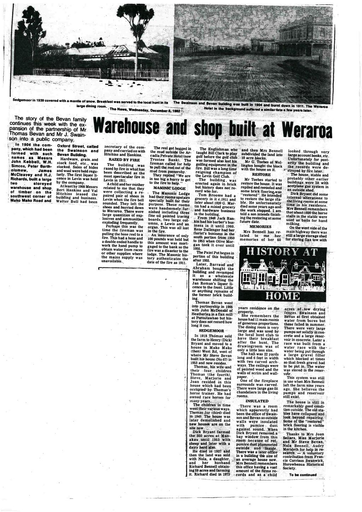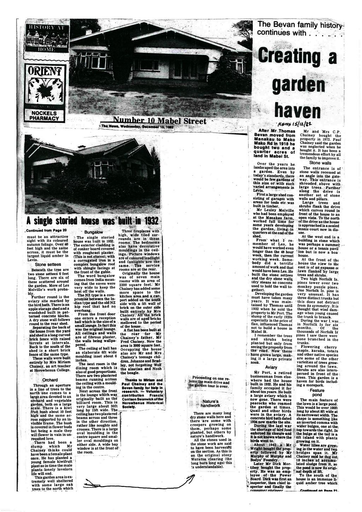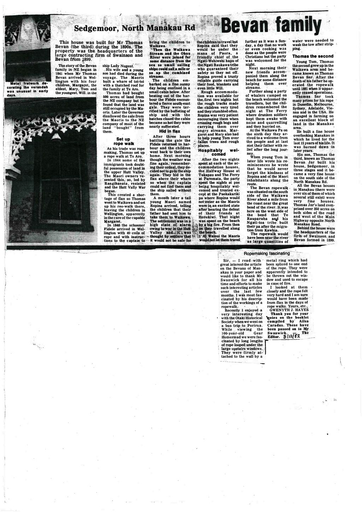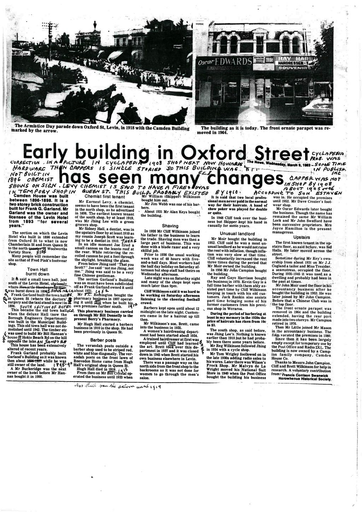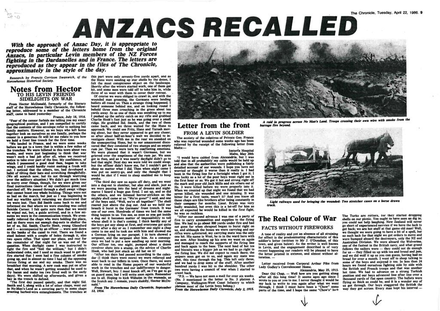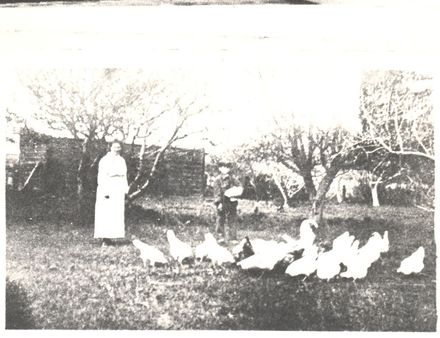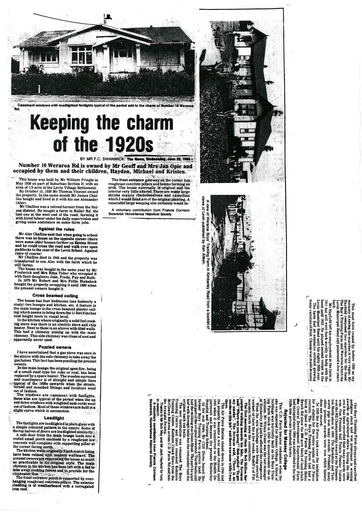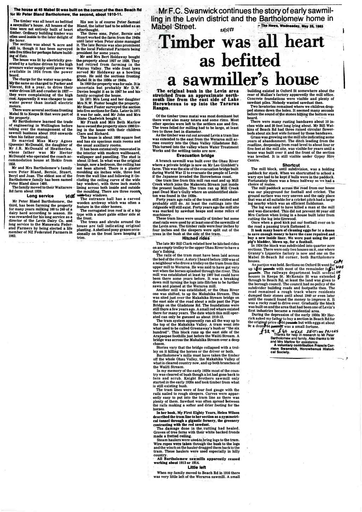The Weraroa Butchery
- Description
The company was still advertising in an Anglican Church Women’s Guild cookery book in 1907. Mr Thomas Devine and Mr William Watkins took over the business at an unknown date, probably about 1910.
 I knew the butchery from 1916 when my family moved to Beach Road. The Watkins family were our neighbours. Frequently over the years Neville Watkins and I, on our way home from school, would go into the shop. The sausage-making process was our main interest. After the meat had been minced, it was mixed with stale bread and other ingredients, and then mixed in the machine. This had a bowl 4 feet (1.2m) wide and 1 foot (0.3m) high.
I knew the butchery from 1916 when my family moved to Beach Road. The Watkins family were our neighbours. Frequently over the years Neville Watkins and I, on our way home from school, would go into the shop. The sausage-making process was our main interest. After the meat had been minced, it was mixed with stale bread and other ingredients, and then mixed in the machine. This had a bowl 4 feet (1.2m) wide and 1 foot (0.3m) high. Two arms rotated, mixing and scraping the mixture off the sides. It was then scooped into a cylinder, with a hand driven plunger, forcing it through a sausage size hole, into the casings. As the very long sausage emerged, the butcher deftly knotted it into clusters of three sausages, hanging the large strings on rails.
The cooler was worth a visit to sample the coolness. The copper outside, with the bubbling fat being rendered down, was attractive if it was a cold day, for the heat of the fire.
Then it was down to the stables (on Keepa St frontage) for fun in the newly laid straw ready for the returning horses of the delivery carts.
Mr “Tommy” Devine was the main delivery man, with a butcher's van. This was covered in with a small butcher’s block at the back. The van would park outside a house, with the butcher cutting meat to the customer’s requirements from large joints. Later motor vans were used, probably in the 1930’s, with the same customer service. The service evolved into delivery of parcelled meat, pre-ordered on a previous day, or by telephone. The service was given two or three times a week.
 The reason that the building was so high was that the shop ceiling was about 18 feet (5.4m) high, allowing for three meat rails one above each other. Hooked sides of mutton or pork and large joints of beef were hoisted up onto the high rails on long hooked poles.
The reason that the building was so high was that the shop ceiling was about 18 feet (5.4m) high, allowing for three meat rails one above each other. Hooked sides of mutton or pork and large joints of beef were hoisted up onto the high rails on long hooked poles. Another reason was that there was a high space between the ceiling and the roof to help to keep the shop cool.
The counter followed the curve of the meat rails, from the south side to the east side, with working room behind it. The cutting-up blocks were cut from a large tree and were about 4 feet (1.3m) wide and about 3 feet (0.9m) high. The cooler ceiling was also very high, about 18feet, allowing for three meat rails high. There was no electricity in Levin until 1924, so the cooling must have been done with ice. This would have been available from the Fresh Food and Ice Company in Arapaepae Road, at least in the pre-1920's.
The original entrance was on the south east corner. Sawdust was laid on the floor and was changed frequently.
In 1921 Mr Thomas Bevan bought the property with a transfer to Devine and Watkins as joint tenants. In the late 1920’s, owing to my mother's health I bought our meat. When buying silverside I would follow the butcher into the brine room. He would have to fork out most of the joints until I was satisfied with the quality. When serving a customer, the butcher would trim surplus fat, especially from chops. This fat, and any meat trimmings, were thrown accurately into the respective containers perhaps 12 feet (3.4m) away.
Mr William Urquhart and Mr George Clark bought the property as the Levin Meat Company and the business in 1946, also running the Avenue Butchery in Levin where Michael’s Hairdressing is now.
The Levin shop was managed by Mr Clark and Mr Urquhart managed the Weraroa shop. It was from then on modernisation took place. The original exterior cladding of galvanized iron was replaced with asbestos board. The ceiling of the shop was lowered and the entrance changed to the east side.
The counter was reduced and altered in direction. Cooled display cabinets were installed and another coolroom built. Some additions were built at the back.
The stables had earlier been converted into a garage for motor vehicles.
The sausage-making machine is now much more compact and the brine tub has been displaced by an injection method.
After some years the partnership was dissolved with Mr. Urquhart running the Weraroa shop. Son, Mr James Urquhart, managed the business for some years.
In 1967 Mr. James Flett bought the property, with Mr Collis Blake being the proprietor from then to about 1968 when Mr John Davies and Mr Laurie Baines bought the business being a branch of their Oxford Butchery in Oxford Street north.
Mr Barry Geange bought the property in 1972. Mr Peter Martin was the proprietor from about 1981 until 1984. Baramac Properties bought the property in 1982. The name is derived from the Christian names of Mr Brian Eastham and his family. Weraroa Farmer’s Meat Company Limited have operated the business since 1984, with Mr Brian Alexander as manager. Mr Bob Skilton came back to the Weraroa Butchery, in Oxford St north to work part time at the Weraroa butchery. The Weraroa Farmer’s Meat Company Limited has as its directors and shareholders Messrs Peter Moody, Alistair Ross-Taylor and Ian Colquhoun. The other shareholders are Messrs Ron Moody, James Ryan and Ken Wilson.
The building has now been demolished. The butchery has moved into one of the shops in the first section of the new Weraroa Shopping Centre which was built on the large butchery section, by the Weraroa Flats Holding of Mr Robert Campbell and Mr Dennis Manz who bought the property recently.
The demolition of the butchery building marks the end of the original Weraroa Shopping area of eleven commercial buildings built between 1895 to 1909. The area was subdivided by Mr Peter Bartholomew in 1894. The Weraroa Post Office and the railway station were built in 1910. I consider that the butchers shop was the oldest commercial building in Levin that has not been partly rebuilt or extensively altered.
The only other remains of the original Weraroa shopping area are part of theChurch of Christ in Seddon St. This building would have been built some time before 1900. Mr Marco Fosella operated a drapery business in the small building. The Church of Christ used it for its first church in Levin. The original small building has been greatly extended.
Identification
- Date
- April 15, 1987
Taxonomy
- Community Tags




